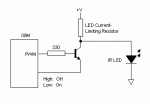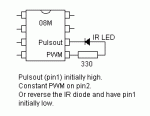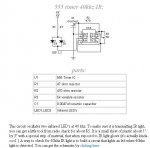My Canon G2 camera has an I.R. remote sensor that responds to a bitstream similar to that sent by infraout. 38 KHz, bit-lengths and spacing the same.
The infraout protocol won't work, because I need to send a start bit and 32 data bits. Can I send timed bursts of PWM to an I.R. LED to simulate this? If so, how do I time them?
I understand that PWM in the background is used to control motors and so on, but I wonder
1. Can a 38KHx PWM at 50% duty cycle be somehow modulated to an output pin on the picaxe?
2. Can a 38KHz pulse be switched on and off quickly and reliably enough to simulate a pulse stream similar to the stream sent by infraout?
I use the Canon cameras in the bush, unattended, to photograph lyrebirds and bowerbirds. I take an exposure every ten seconds for two hours, and the timing mechanism I have made is about the size of half a brick and has a relay requiring 12 volts. If I can get the picaxe to do it, the whole thing would fit into a four- AAbattery case together with two batteries.
I have experimented with the 08M and can use pulsout to send unmodulated pulses of the right timing. I feel I am close, but I need help.
All responses will be valued.
The infraout protocol won't work, because I need to send a start bit and 32 data bits. Can I send timed bursts of PWM to an I.R. LED to simulate this? If so, how do I time them?
I understand that PWM in the background is used to control motors and so on, but I wonder
1. Can a 38KHx PWM at 50% duty cycle be somehow modulated to an output pin on the picaxe?
2. Can a 38KHz pulse be switched on and off quickly and reliably enough to simulate a pulse stream similar to the stream sent by infraout?
I use the Canon cameras in the bush, unattended, to photograph lyrebirds and bowerbirds. I take an exposure every ten seconds for two hours, and the timing mechanism I have made is about the size of half a brick and has a relay requiring 12 volts. If I can get the picaxe to do it, the whole thing would fit into a four- AAbattery case together with two batteries.
I have experimented with the 08M and can use pulsout to send unmodulated pulses of the right timing. I feel I am close, but I need help.
All responses will be valued.








